Is Instinct a Technology?
Autonomous Futures envisions a future where communities own, operate, and determine the appropriate processes of development and application(s) for emerging technologies and ai to support our society (About). This work requires that we think differently about existing classifications for what is considered technology in the first place.
The aspiration of pursuing community-driven digital technologies can feel overwhelming. The barriers, after all, are very real and difficult to overcome. Among such barriers, the imperative of monetary profitability in a market-driven economy and the lack of public funding available to invest in such ventures rank as top challenges. This might lead us to rue how seemingly impossible it is to pursue technologies for community benefit—especially at scale—if such efforts can only be achieved through volunteer efforts and free labor, for example. A volunteer-based approach is not sustainable within our current socio-economic environment.
In the face of such big systemic challenges, it can be easier to conjure the multitude of reasons such an aspiration might not work than to consider the ways it could succeed. As a result, we are at risk of self-censoring and falling into the trap of technological determinism that invalidates community-driven innovation before its benefits and possibilities are even considered.
Breaking Down Old Nature/Technology Binaries
Stories, games, art, music, and culture open us up to imagine alternative ways to get there. The cultural texts that have inspired Autonomous Futures invite us to see the world through different perspectives that are routinely ignored, dismissed, or rendered less valuable, less important than others. They invite us to imagine and invent new possibilities that chip away at the barriers that make such aspirations impossible to even consider.
Over the holidays, the AF co-founders met virtually to watch and discuss Nanobah Becker’s 15-minute film from 2012: The 6th World. The short film imagines a Navajo astronaut, Tazbah Redhouse, piloting the first public-private multilateral spaceship sent to colonize Mars. The chief scientist on the mission is growing a new species of purely utilitarian, genetically modified corn that is stripped of all of what the scientist calls the “unusable parts”—the husks, the tassels.
Stirred by a dream, Tazbah struggles to reconcile her intuitions that seem to tell her the mission is doomed with the rigid rules of Western “hard science” that dictate its conditions. Emboldened by a fellow leader in the Navajo community who visits the spaceship and affirms her intuitions and inclination to draw ancestral wisdom into the mission, Tazbah breaks the rules. She begins to grow “contaminated” corn from her community against the scientific protocols and saves the mission as a result. The success of the mission confirms not only the primacy of the Navajo community’s corn as a life giving force on a new planet—it also illustrates the importance of breaking down binaries that purport divisions between science and spirit, nature and culture. Ultimately, the cob of corn together with the “non-utilitarian” tassels, husks, and stalks save the mission to Mars.
Human Capabilities Can Reframe Machine Capabilities
The film begged AF co-founder Ruffin to ask: “do we consider instinct a technology?”
She went on to explain that instincts, when properly calibrated, keep us safe and alive. As a tool that can be cultivated and nurtured to help us solve problems, protect ourselves, and support our individual and collective flourishing, instincts can indeed be considered a technology. We have previously discussed how “hope is a technology” insofar as we can design and cultivate it for practical purposes and to accomplish tasks. Similarly, the benefits of considering the question of instinct as a technology are multiple.
For one, if we consider instincts to be a technology, that enables it to be part of the discourse on technology, a discourse that too often seeks to differentiate the “usable parts” of technology – the hardware and the software – from the whole culture of emerging technology that is mediating how we communicate, how we build community, how we learn, how we work, etc. By situating instinct, dreams, and ancestral knowledge within the discourse of hard sciences and “innovation,” as Nanobah Becker does in The 6th World, we can integrate a more holistic and deeper understanding of how technological tools shape and produce who we are. We can, in turn, shape them to better reflect what we want these tools to be. Scientists like Robin Wall Kimmerer offer models for this way of thinking in her book Braiding Sweetgrass.
When we create false divisions between “human” technologies and “digital” technologies, we risk excluding communities outside of the tech industry from participating in technological development. This artificial separation can make people who aren't directly involved in manufacturing emerging technologies feel like they aren't legitimate stakeholders in shaping the future of the machines and technologies that impact our communities and our daily lives. Reframing technology to include the tools available to everyone – tools like instinct and imagination that don’t require venture capital investments to cultivate, nurture, and pursue – is worth considering as a worthy starting point for imagining what realizing a dream of community owned and operated technologies might look like.





